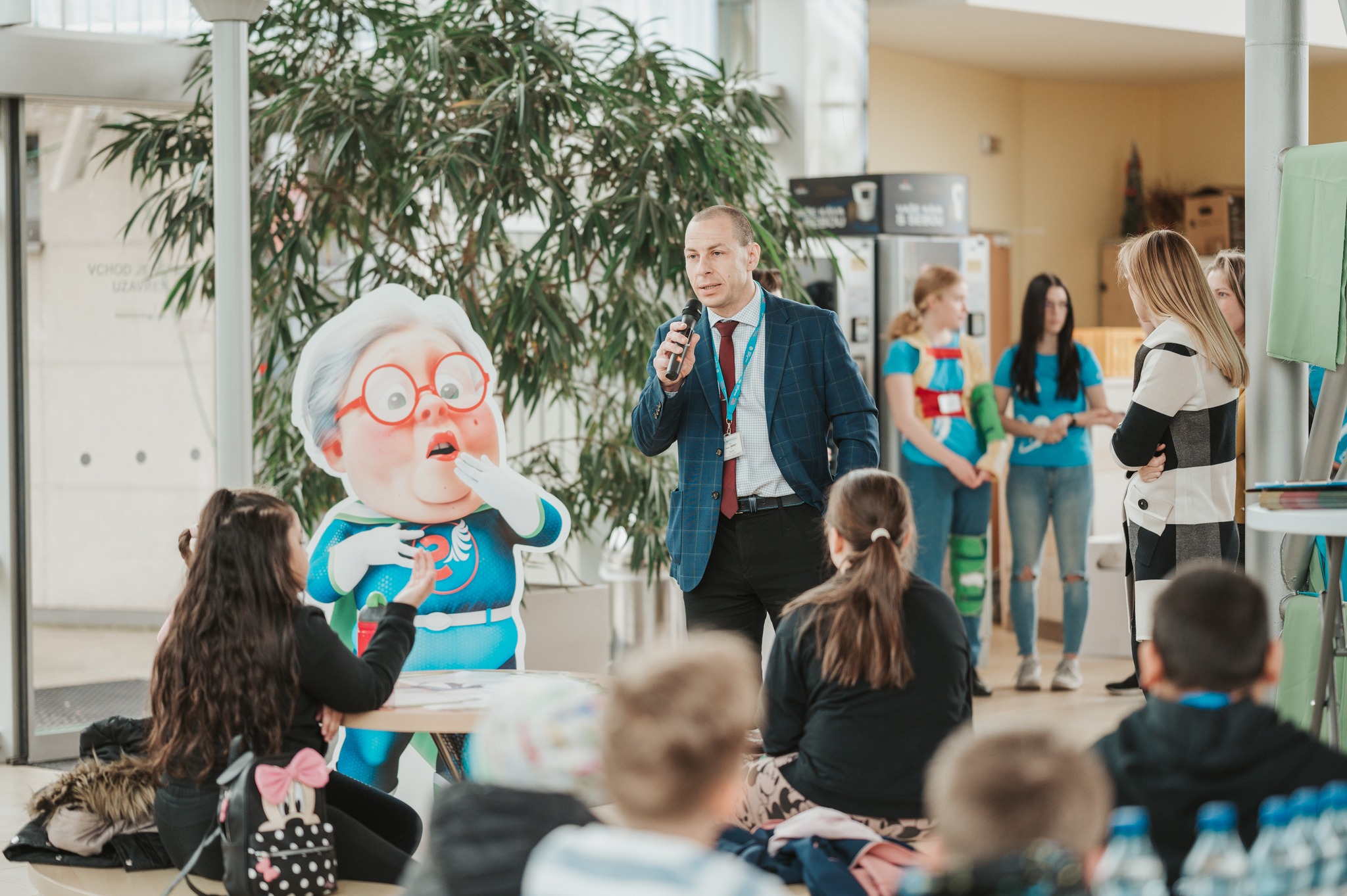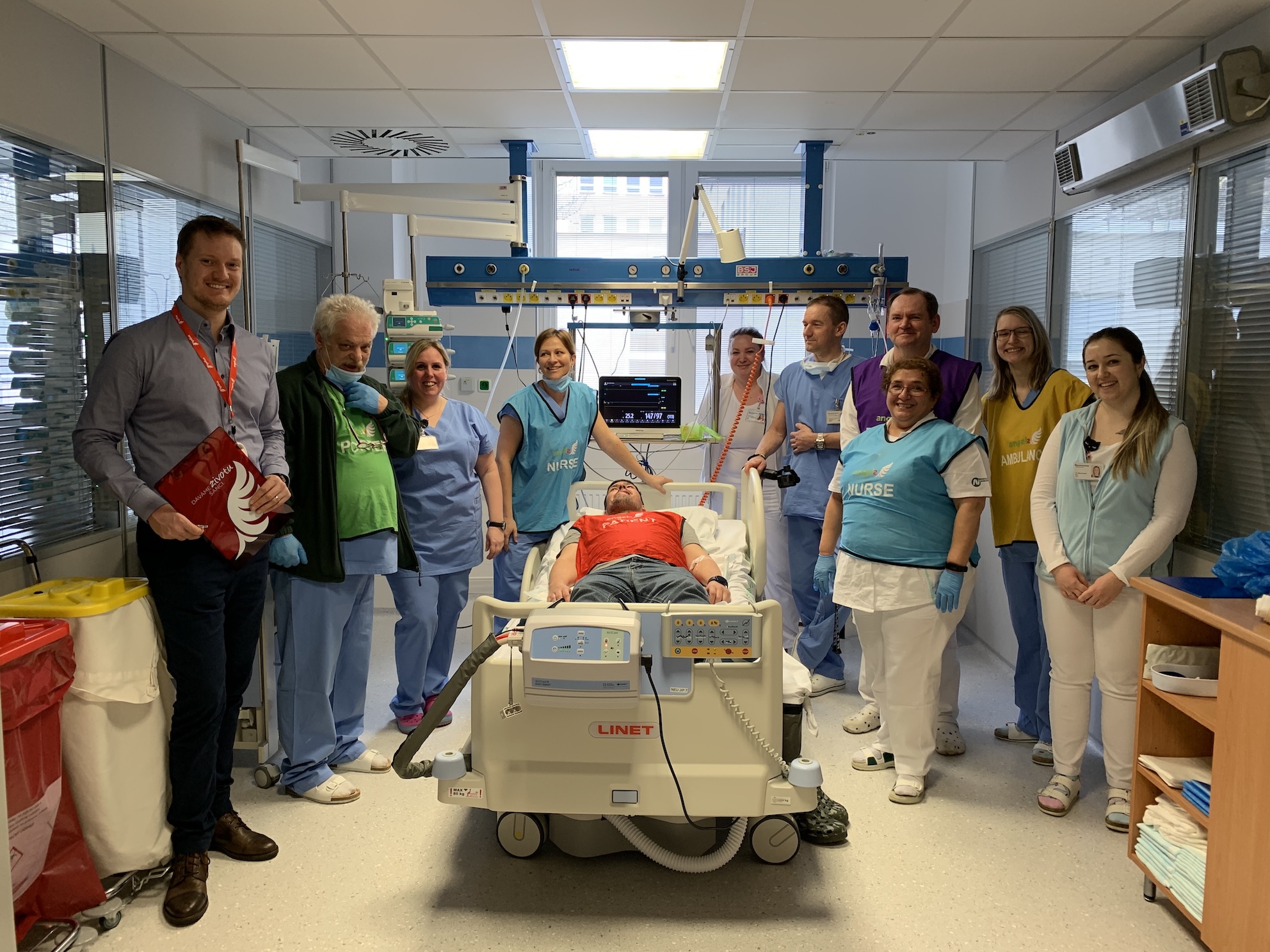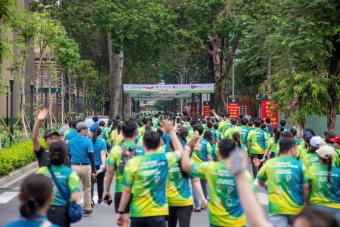In less than a year after Angels set itself the goal to convert 100 Angels Regions by December 2027, the Czech Republic alone has delivered five percent of the global target.
Five out of the country’s 14 self-governing regions or kraje have already reached Angels Region status, which means they have achieved the hospital and EMS performance standards for stroke care set by the program, and reached public awareness education targets.
Over four million Czech citizens now officially live in safe communities for stroke, representing almost 40 percent of the total population. If you were to add all five regions together they would make an Angels Region measuring over 30,000 square kilometres, equal to 39 percent of the total terrestrial area. It seems just a matter of time before the Czech Republic becomes the first country in the world to be recognized as an Angels Region in its entirety.

Give us one year
Central organization, a national stroke centre accreditation program, one ambulance service per region, and coordination with the Ministry of Health and regional authorities meant the Czech stroke community were on the front foot from the word go. This is the view of stroke neurologist and Czech Stroke Society chair Dr Aleš Tomek who predicts that it will take another year for every region in the country to be converted.
His home turf, Prague, is not yet an Angels Region. They’re missing one parameter, the FAST Heroes implementation goal, so involving more schools is on the agenda. Another limiting factor is that most but not yet all of the regional ambulance services have won EMS Awards. They have launched a quality program for EMS that was motivated by the Angels Regions strategy. Things are moving fast, he says. “We will get it done in a year.”
There’s no such thing as too much winning. Of the 47 accredited stroke centres in the Czech Republic, 45 received ESO Angels Awards in 2024, and 35 are ESO certified centres (second only to Germany.) Nevertheless, the chance to become an Angels Region is a new motivating factor for hospitals that have been at the top of their game for years. It’s also an opportunity for regional leadership to shine and be recognized for their work.
Countries wanting to borrow a leaf out of the Czech Republic’s book should prioritize “cooperation, structure and organizing at central or regional level,” Dr Tomek says.
“We are lucky to have central organization, but if you don’t, go meet with your partners in the region. Meet regularly. For twenty years we have been meeting at least four times a year. That’s why we’re ahead.”

A tool that works
“We built the system from the bottom up, with a lot of enthusiasm from doctors and Angels,” says Prof. Robert Mikulik of RES-Q, the Czech-built international stroke quality registry that in under a decade has become one of the largest in the world. It is also the primary evaluation portal for the Angels Awards progams. Quality monitoring is now part of the national policy and data is overseen by a quality committee in the Ministry of Health. Tracking and reporting on a set of quality indicators is mandatory, and since 2015 data from RES-Q has been shared to all centres, creating the conditions for mutual competition.
“In RES-Q we have a tool that works very well,” Prof. Mikulik says. There’s also a high degree of organization at a human level, with people working together to define needs and meet gaps, and an important platform for sharing information – at over 50, the Czech & Slovak Cerebrovascular Conference may be the oldest stroke conference in the world. (The Czech and Slovak Neurology and Neurosurgery Journal is even older, dating back to 1938.)
RES-Q training is on the agenda, in a workshop where stroke centre representatives can have their questions answered and receive information about new and upcoming developments.
Artificial intelligence is coming to RES-Q with the development of an AI tool to automatically populate data fields from various sources that could be implemented as soon as next year.
“Standardizing discharge summaries will help improve the quality of data as everyone will be reporting the same things,” Prof. Mikulik says.
Well certified and well-functioning
Stroke centre certification has quite a long history in the Czech Republic, says Dr Ondřej Škoda, head of the neurology department at Hospital Jihlava in Vysočina Region, and a key driver of ESO certification for Czech stroke centers. National certification by the Ministry of Health began in 2011. The Czech Stroke Society designed the accreditation criteria according to ESO recommendations and when ESO certification was introduced in 2016, they were able to secure fast-track application for accredited Czech stroke centres along with those in Germany and Switzerland. As a member of the ESO stroke centre committee, Dr Škoda had had the opportunity to bring the Czech experience to the ESO certification process.
The stroke unit and stroke centre network is not only well certified but also well-functioning, Dr Škoda points out, although he agrees certification is an important reason why a high level of hyperacute care is available throughout the Czech Republic.
He says, “It’s one of the reasons we are the second best in Europe in IVT and fourth or fifth in mechanical thrombectomy.” It’s arguably also why the Stroke Action Plan for Europe goal of treating 90 percent of stroke patients in a stroke unit by 2030 has already been achieved here.
Certification is valid for five years, but an annual evaluation process is built into the system, ensuring a continuous improvement mindset.
Vysočina is not yet an Angels Region, largely because mountainous terrain means its relatively small population needs an additional stroke centre. The priority now is to prepare this hospital for accreditation in January 2026, and manage the impact on the distribution of ambulance services.

Educating the community
Awareness campaigns and educational programmes aimed at the general public are an integral part of the care of stroke patients in the Czech Republic, says Dr Jiří Neumann of Hospital Chomutov in Ústecký Region. “For 20 years, the Czech Stroke Society has participated in awareness and information campaigns to educate the public about stroke symptoms and the importance of prompt action to save health and life. These campaigns also highlight the risk factors for stroke and promotes lifestyle changes to prevent stroke.”
Currently, annual awareness campaigns mark Stroke Awareness Day on 15 May and World Stroke Day on 29 October.
As well as support for the FAST Heroes campaign, awareness education projects include the 11-year-old HOBIT program, which aims to teach secondary school children to recognize and respond to stroke symptoms, with the emphasis on timely EMS activation.

Moravskoslezský kraj
Population: 1,189,000
Hospitals: 6
EMS: 1
In the Moravian Silesian Region located in northeastern Czechia, the key drivers of change have familiar names. Prof. Michal Bar from Faculty Hospital Ostrava, Dr Daniel Václavík (Hospital Agel Vítkovice) and Petr Jaššo (EMS education chief for the region) are all members of the multidisciplinary Angels steering committee in the Czech Republic. They took the lead, using data from RES-Q, the Ministry of Health and health insurance companies to conduct a comprehensive performance analysis to find and target weak spots in the region. Education and standardization delivered success. After an updated EMS stroke card was introduced that incorporated ASLS methodology (including the BE-FAST/MEND evaluation scale) and specified rules for triage of patients based on factors such as time from symptom onset and mRS score, the EMS won a diamond award in Q3 of 2024. At Hospital Agel Vítkovice, Dr Václavík introduced a new hospital checklist that among other features mirrored aspects of the EMS stroke card to improve neurologist-paramedic communication. To meet awareness education targets, healthcare professionals supported FAST Heroes implementation in schools, an intervention lead by Dr Hana Paloušková who, together with Dr Svatopluk Ostrý in the South Bohemia Region, was the first official FAST Heroes ambassador in the Czech Republic.
Karlovarský kraj
Population: 295,077
Hospitals: 2
EMS: 1
Karlovy Vary Region in northwestern Czechia is where we find Dr Aleš Novák from Hospital Sokolov and Dr Evžen Tarasov (Karlovy Vary Regional Hospital). They led the change along with the Karlovy Vary EMS team whose active support for the FAST Heroes campaign meant that the region exceeded the target by 340 percent. Both hospitals also promoted the campaign on social media and at Karlovy Vary Regional Hospital, Dr Tarasov and his colleagues visited schools and organized a seminar for local teachers. The EMS in this region stood out, Angels consultant Martin Liptay says. “They were active users of our elearnings including the ASLS course, and took the EMS Awards very seriously. The organization is quite small but in absolute numbers they have the second-highest number of registered users (94) and elearnings completed (92) in the Czech Republic, and proportionally, they’re on top.” This dedication to continuous learning plus regular data collection saw them win four diamond awards in 2024.
Jihomoravský kraj
Population: 1,277,000
Hospitals: 6
EMS 1
The South Moravian Region is located in southeastern Czechia, and its capital, Brno, is where the stroke quality improvement registry RES-Q has its head-quarters. Here, RES-Q training and a focus on quality in data capture saw Znojmo Hospital back in the awards after a three-year absence. The route to Angels Region status was charted by the regional working group that met to discuss opportunities to improve the care provided by hospitals and EMS. The region’s EMS is a regular participant in the EMS Awards with two diamond awards to their credit, and because Brno itself is the nerve centre for FAST Heroes implementation in the Czech Republic, when it came to meeting awareness targets the South Moravian Region was first across the line.
Jihočeský kraj
Population: 654,505
Hospitals: 3
EMS: 1
No-one was surprised when the South Bohemia Region was among the first Angels Regions in Europe. This region had everything going for it. At Hospital České Budějovice, the head of neurology Dr Svatopluk Ostrý is a passionate driver of change. Hospital Písek has an average door-to needle time of 17 minutes, and the lead physician of the stroke unit Dr Robert Rezek is also an ASLS instructor. And the ZZS JčK is lead by Dr Marek Slabý who is also president of the National Association of EMS and represents the district Tábor in the Senate of the Czech Republic. Optimization of care at the regional level is made easier by the fact that all the hospitals including the three stroke centres are controlled by the regional authority. Martin says. “This means the stroke network is intensively discussed on the political level in the region, and there’s close collaboration between the hospitals and the office of the mayor, Dr Martin Kuba, who happens to be a physician with experience in the emergency medical services.” When we last spoke to the change makers in this southern part of historical Bohemia (in May 2024), Angels Region status was one hospital award away. Since then, training in dysphagia screening and improved data collection have earned Hospital Jindřichův Hradec its first ESO Angels Award, and the FAST Heroes campaign benefited from the high-level advocacy lead by Dr Ostrý and Dr Kuba.
Ústecký kraj
Population: 811,169
Hospitals: 6
EMS: 1
Located between Prague and the border with Germany, Ústecký Region in northwestern Bohemia wasn’t targeted for Angels Region conversion in 2024. However, having maintained standards achieved during previous Angels consultancies, they met the criteria for Angels Region status without further intervention besides ongoing national support. There are several reasons for this, including the leadership provided by Dr David Černík, leading stroke unit physician at comprehensive center, Masaryk Hospital in Ústí nad Labem, and Czech Stroke Society working group member Dr Jiří Neumann (Hospital Chomutov). All six hospitals in the stroke network are owned by the same healthcare provider “Krajská zdravotní, a.s.”, and the EMS is a diamond-winner and the only one in the country that provides primary air transport to stroke patients from remote locations in the region. Starting three years ago, ZZS Ústeckého kraje sends helicopters for FAST+ patients who are candidates for mechanical thombectomy. This, along with a well-established drip-and-ship model, has resulted in Ústecký region having the highest number of recanalizations in the country. The EMS also benefits from ongoing education incorporating aspects of ASLS, and in the town of Most, Dr Ján Macko invited local paramedics who had attended a seminar on evaluating stroke symptoms in the field on a tour of his department where they could meet patients and learn about their stories. Nurses offer another key to the region’s success. Two of the nurses on the Angels Nurses Steering Committee – Kateřina Rusková and Petra Pöschlová – work in this region and are active in nursing education. At Masaryk Hospital in Ústí nad Labem, At Masaryk Hospital in Ústí nad Labem, Dr David Černík has made Stroke Basics for Nurses in the Angels Academy an integral part of training for nurses who come into contact with stroke patients.To date, 82 nurses at this hospital have earned stroke nurse certification by completing the course, four times more than South Bohemia’s Hospital České Budějovice in second place. They were in addition required to pass a written exam based on the course material. Drs Černík and Neumann and their colleagues are also long-standing supporters and initiators of public awareness activities including FAST Heroes.


